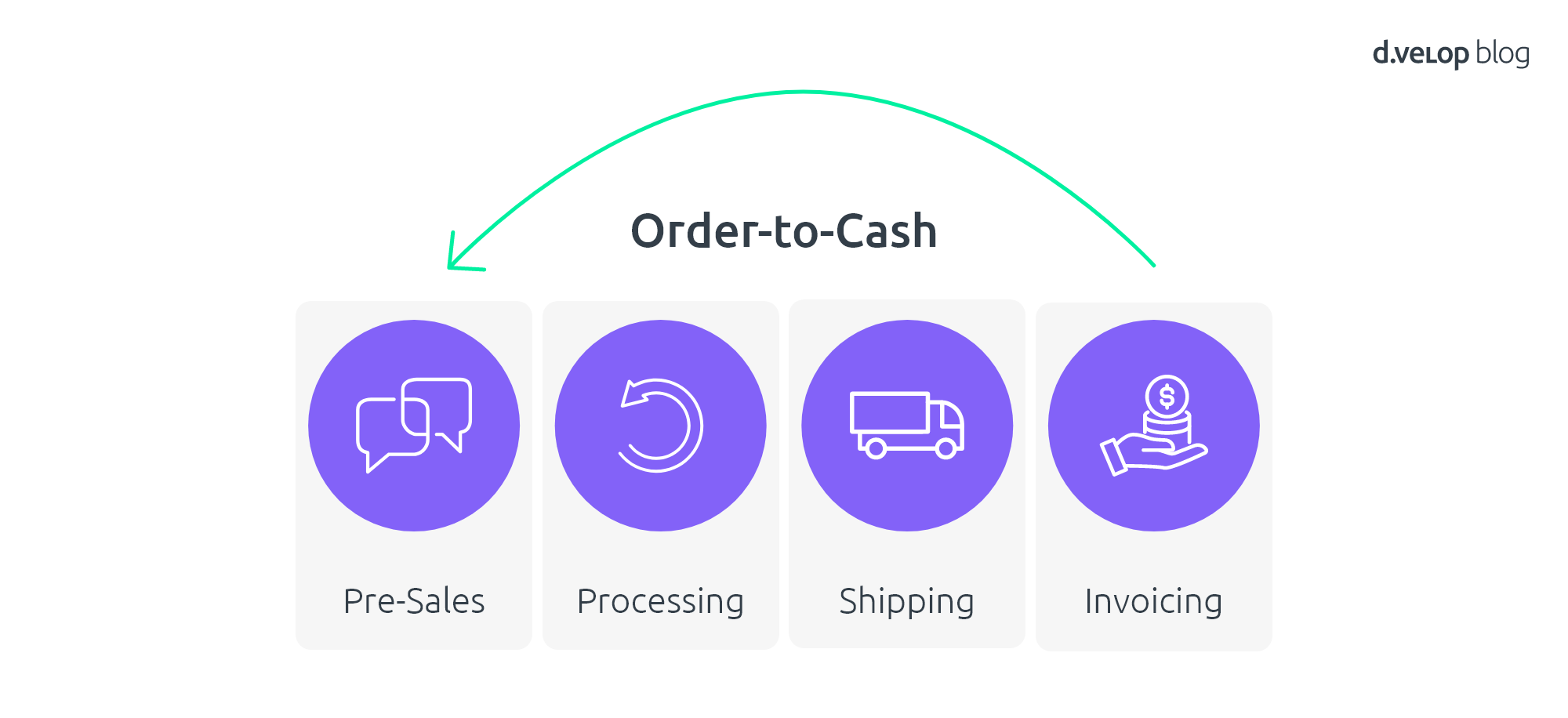How does a customer order actually come about in your company? And which processes are behind the successful shipment up to the receipt of payment? These are precisely the topics that form part of the Order to Cash process in SAP. What exactly lies behind this and what Order to Cash has to do with efficiency – we’ll explain!
What does Order to Cash mean?
Literally translated, Order to Cash means “from order to payment” and stands for the process from the incoming customer order to the receipt of payment in the company. It is one of the most common processes in SAP ERP and SAP S/4HANA and handles revenue generation with customers. The Order to Cash process (O2C) is the counterpart to the Purchase-to-Pay process (P2P), which maps procurement in the company.
Order to Cash – A process consisting of four steps
The entire order to cash process consists of four phases. The phases “Pre-Sales”, “Settlement”, “Shipping” as well as “Invoicing” link to each other in the mentioned order and consist of different subordinate processes.

1. pre-sales activities
At the beginning of the order-to-cash process is the phase of pre-sales activities. For example, the customer approaches the company with an inquiry and there is initial non-binding contact. The customer’s inquiry is processed and, if necessary, a quotation is prepared. The offer contains binding data, such as product data or details of services, prices and other information. After the offer has been sent out, prices and delivery terms are negotiated in the follow-up. Further process steps in pre-sales activities are the final contract negotiation or the contract negotiation, or even the agreement of a delivery schedule. The SAP user can skip the pre-sales steps until the quotation is issued, but the steps for processing are readily used.
2. order processing
Order processing is the core of the order to cash process. The order processing process phase begins with the confirmation of the order. With the help of the SAP sales order document, the customer order is summarized with all necessary details, such as information about the goods or services, prices, delivery date and quantities, transport route and billing information. This data is the starting point for all further steps in the Order to Cash process.
3. shipping
Shipping is carried out with the help of the delivery document. Thanks to all the necessary information summarized in one document, picking, packing and transportation are carried out at this stage.
4. invoicing
In the final stage of the process, invoicing takes place. Billing in SAP creates a document that serves as the basis for creating invoices to the customer. With the help of the billing documents in SAP, invoices, credit and debit memos can be created, and billing cancellations can be performed. Through integration with the SAP FI module, automatic postings can be triggered. In the final step, the system monitors whether payment has been received.
Order to Cash and its pitfalls
Companies naturally want to operate profitably. During the sales process, the revenue must be higher than the costs incurred. Not inconsiderable are the internal processes, which, as just mentioned, lead from customer inquiry to receipt of payment. In addition, competition is usually fierce, and customer satisfaction plays a decisive role. The customer wants to receive the ordered goods or services as quickly as possible or on the desired date.
The entire sales process involves many departments that are involved in the same process, but often pursue different goals and work in different routines. The high number of people involved in the process creates long lead times, and the various media disruptions lead to a lack of transparency.
For example, while the customer inquiry as well as the order processing are done digitally, the delivery document as well as the delivery bill is printed out by the shipping department. The invoice, in turn, is generated and processed digitally. The order-to-cash process in SAP has the potential to be optimized with the help of digital solutions. Exactly what this looks like will be discussed next.
SAP O2C with d.velop
To be able to process customer orders more efficiently and transparently, we need to automate processes. In order to create a digital basis, we should already start at the beginning of the process chain.
d.velop has developed a solution for digital order entry. The customer order is also called Sales Order (SO) and is transferred with our solution with the order data to the Classifier Workflow platform integrated in SAP. The reading of order information for paper-based documents works with the help of OCR software. Using recognition software (AI), the key data of the order document, such as product information, quantity or customer data, is determined and validated with SAP master data. This is then used to generate a sales order document for further processing in SAP. Now the order can be viewed, checked and released. As a user, you can define the release steps individually for yourself. After the order has been released, an SAP document (SO) is generated, which enables further digital processing, such as shipping or entering the invoice. All order-related documents are collected in a central file so that everyone involved has a transparent view of the order.
Conclusion
In conclusion, it can be said that the order-to-cash process in SAP provides a good basis for automating a sensibly designed process. Due to some stumbling blocks caused by media disruptions and the many employees involved, digitization of the process is a good way to make your company even more efficient and increase customer satisfaction.
